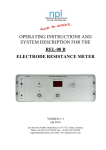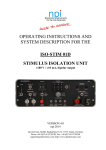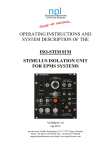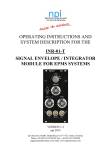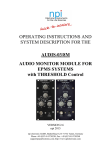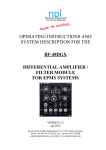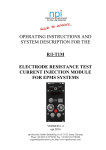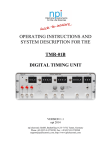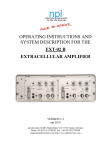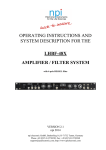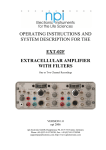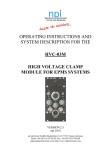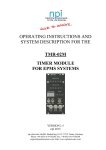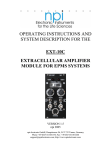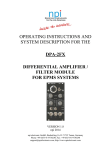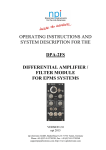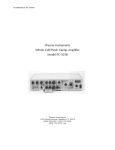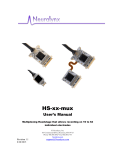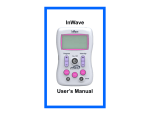Download ISO-01B Manual - NPI Electronic Instruments
Transcript
OPERATING INSTRUCTIONS AND SYSTEM DESCRIPTION FOR THE ISO-STIM 01B STIMULUS ISOLATOR VERSION 1.2 npi 2014 npi electronic GmbH, Bauhofring 16, D-71732 Tamm, Germany Phone +49 (0)7141-9730230; Fax: +49 (0)7141-9730240 [email protected]; http://www.npielectronic.com ISO-STIM 01B User Manual _______________________________________________________________________________________________________________ Table of Contents 1. Safety Regulations .............................................................................................................. 3 2. Special Safety Notice for High Voltage Instruments.......................................................... 4 3. ISO-STIM 01 B .................................................................................................................. 5 3.1. System Description ...................................................................................................... 5 3.2. Description of the Front Panel ..................................................................................... 5 3.3. Description of the rear panel ....................................................................................... 8 3.4. Operation ..................................................................................................................... 9 3.4.1. Connections – Noise Reduction .................................................................. 9 3.4.2. Operation modes .......................................................................................... 9 4. Battery Pack and Charger ................................................................................................... 10 5. Power supply....................................................................................................................... 11 6. Technical Data ISO-STIM 01B .......................................................................................... 12 ___________________________________________________________________________ version 1.2 page 2 ISO-STIM 01B User Manual _______________________________________________________________________________________________________________ 1. Safety Regulations VERY IMPORTANT: Instruments and components supplied by npi electronic are NOT intended for clinical use or medical purposes (e.g. for diagnosis or treatment of humans), or for any other life-supporting system. npi electronic disclaims any warranties for such purpose. Equipment supplied by npi electronic must be operated only by selected, trained and adequately instructed personnel. For details please consult the GENERAL TERMS OF DELIVERY AND CONDITIONS OF BUSINESS of npi electronic, D-71732 Tamm, Germany. 1) GENERAL: This system is designed for use in scientific laboratories and must be operated by trained staff only. General safety regulations for operating electrical devices should be followed. 2) AC MAINS CONNECTION: While working with the npi systems, always adhere to the appropriate safety measures for handling electronic devices. Before using any device please read manuals and instructions carefully. The device is to be operated only at 115/230 Volt 60/50 Hz AC. Please check for appropriate line voltage before connecting any system to mains. Always use a three-wire line cord and a mains power-plug with a protection contact connected to ground (protective earth). Before opening the cabinet, unplug the instrument. Unplug the instrument when replacing the fuse or changing line voltage. Replace fuse only with an appropriate specified type. 3) STATIC ELECTRICITY: Electronic equipment is sensitive to static discharges. Some devices such as sensor inputs are equipped with very sensitive FET amplifiers, which can be damaged by electrostatic charge and must therefore be handled with care. Electrostatic discharge can be avoided by touching a grounded metal surface when changing or adjusting sensors. Always turn power off when adding or removing modules, connecting or disconnecting sensors, headstages or other components from the instrument or 19” cabinet. 4) TEMPERATURE DRIFT / WARM-UP TIME: All analog electronic systems are sensitive to temperature changes. Therefore, all electronic instruments containing analog circuits should be used only in a warmed-up condition (i.e. after internal temperature has reached steady-state values). In most cases a warm-up period of 20-30 minutes is sufficient. 5) HANDLING: Please protect the device from moisture, heat, radiation and corrosive chemicals. ___________________________________________________________________________ version 1.2 page 3 ISO-STIM 01B User Manual _______________________________________________________________________________________________________________ 2. Special Safety Notice for High Voltage Instruments HIGH VOLTAGE!! RISK OF ELECTROCUTION!! Observe extreme caution when working with this instrument!!! 1) Always connect high voltage power supplies to protective earth!! 2) Do not touch connections unless the instrument is turned off and the capacitance of both the load and power supply are earthed!! 3) Allow adequate time for discharge of internal capacitance of the power supply!! 4) Do not ground yourself or work under wet or damp conditions!! 5) Servicing should be only done by qualified personnel aware of the hazards!! 6) If in doubt, return to supplier for servicing!! ___________________________________________________________________________ version 1.2 page 4 ISO-STIM 01B User Manual _______________________________________________________________________________________________________________ 3. ISO-STIM 01 B 3.1. System Description The ISO-STIM 01B stimulus isolation unit is designed for application of extracellular stimuli, e.g. in brain slices. The output signal is optically isolated from ground and can either be a constant voltage up to ±100 V or a constant current up to ±10 mA. A TTL signal at the TRIGGER INPUT generates one stimulation pulse with adjustable pulse length, amplitude and polarity. An additional DIRECT INPUT allows the pulse length to be externally controlled, whereas amplitude and polarity are controlled by the device itself. For both timing modes the generated pulses can be unipolar or bipolar. In bipolar mode an interphase gap (IPG) of adjustable length can be inserted between the two pulses. 3.2. Description of the Front Panel Figure 1: front panel view of ISO-STIM 01B (1) POWER LED LED indicating that the ISO-STIM 01D is powered on. (2) POWER ON/OFF switch Switch to turn POWER of the ISO-STIM 01D ON or OFF, respectively. (3) DURATION (ms) digital potentiometer Potentiometer that sets the duration of the stimulus generated by the built-in timing unit. ___________________________________________________________________________ version 1.2 page 5 ISO-STIM 01B User Manual _______________________________________________________________________________________________________________ (4) OPERATION MODE (BIPOLAR/UNIPOLAR) switch (5) AMPLITUDE 10-turn potentiometer Potentiometer that sets the amplitude of the stimulus generated by the internal timing unit. The maximum range is selected with the OUTPUT rotary switch (#15). (6) +/- POLARITY switch Switch for setting the polarity of the stimulus. (7) OVER + LED LED indicating that the amplifier is 10% below its positive limit (limit is ±100V in VOLTAGE OUTPUT MODE). In CURRENT OUTPUT MODE the limit (±100 V) is set by the corresponding voltage at the electrode due to Ohm’s Law [V = I*R]), i.e. this control indicates during an experiment in CURRENT OUTPUT MODE that the electrode resistance increases and the amplifier is not be able to provide the current which is set if the electrode resistance increases further. (8) STIM LED LED indicating the application of a voltage or current stimulus. (9) OVER – LED See (#7). (10) CAP. COMP trim pot The CAP.COMP. potentiometer compensates for the input capacitances in isolated CURRENT output operation only. Capacity compensation is achieved by turning the potentiometer with a small screw driver clockwise, until the current signal at the oscilloscope is as square as possible. Important: If the CAP.COMP. is overcompensated in CURRENT MODE, the stimulus isolator will ring and not work properly! (11) CHASSIS connector Jack linked to the CHASSIS. The green banana connector of the supplied cable is connected here. (12) ISOLATED OUTPUT plug (negative) The ISOLATED OUTPUT signal is available at two plugs (red and black). The polarity of the +/- POLARITY switch (#6) is not changed, i.e. the red plug is positive (+) if the output polarity switch is set to +. This signal is completely isolated from ground. The black jack serves as reference point for the isolated output signal. The black banana connector of the supplied cable is connected to the black jack and the red to the red jack. Caution: THIS INSTRUMENT HAS A HIGH VOLTAGE OUTPUT (UP TO ±100 V)!!! Do not touch these pins or bare wires connected to these pins. Always turn power off if you manipulate devices connected to these pins. (13) ISOLATED OUTPUT plug (positive) See (#12). ___________________________________________________________________________ version 1.2 page 6 ISO-STIM 01B User Manual _______________________________________________________________________________________________________________ (14) OFFSET trim pot Trim-pot to compensate for the OFFSET of the stimulating electrode. It is recommended to compensate the offsets only in a completely warmed up condition i.e. after 30 minutes warmup time. Compensation procedure is also possible in current mode. (15) OUTPUT rotary switch Switch for selecting current or voltage stimulation and for setting the maximum range to be set with the AMPLITUDE potentiometer (#5). (16) IPG TIME (µs) potentiometer with switch Potentiometer to select the interphase gap time (IPG) in bipolar stimulation mode (see 3.4.2). IPG is turned off in the leftmost position (switch). (17) DIRECT INPUT (TTL) BNC connector A TTL signal can be fed in here to trigger the output of the ISO-STIM-01D. Amplitude will be set by #5, #6, #15. In unipolar mode (#4) the output will be active as long as a TTL HIGH signal is fed into this input. In bipolar mode the output will be active for the time a TTL HIGH signal is fed into this input. After this time an additional puls is generated at the output with the same duration and amplitude but with opposite polarity. The time between these two pulses is set by the IPG TIME potentiometer (#16). (18) TRIGGER INPUT (TTL) BNC connector A TTL signal can be fed in here to trigger the internal timing unit. Duration of the output signal is set by the DURATION potentiometer (#3). Amplitute is set by #5, #6, #15. (19) MANUAL TRIGGER pushbutton swich This pushbutton has the same functionality as the TTL input (#18), but is for manual operation. (20) REMOTE TRIGGER BNC connector (optional) This connector can be used to connect a passive remote hand switch provided by npi. ___________________________________________________________________________ version 1.2 page 7 ISO-STIM 01B User Manual _______________________________________________________________________________________________________________ 3.3. Description of the rear panel Figure 2: rear panel view of ISO-STIM 01B On the rear panel of the ISO-STIM 01B there is only one SubD connector. This connector is used to connect the ISO-STIM 01B either to its power supply or to the battery pack. ___________________________________________________________________________ version 1.2 page 8 ISO-STIM 01B User Manual _______________________________________________________________________________________________________________ 3.4. Operation 3.4.1. Connections – Noise Reduction The ISO-STIM 01B comes with a battery pack with a SubD cable which is connected to the stimulus isolation device. The corresponding connector at the ISO-STIM 01B are located at the rear panel. Note: A possible source of noise is the chassis of the stimulator. In a noisy environment it may act as an antenna picking up 50 Hz or 60 Hz noise respectively, especially when operating with current stimuli. In this case the noise is substantially reduced if the chassis is connected to ground (see also #11, Figure 1). The stimulation electrode is connected to the isolated output (see Figure 1). We recommend to use a bipolar electrode for stimulating nerve bundles. This will produce only a short stimulation artifact at the beginning. Remember: If unipolar electrodes are used the whole slice will be stimulated resulting in a DC shift of the whole slice. 3.4.2. Operation modes BIPOLAR: The isolator is capable to generate biphasic stimuli by switching the stimulus mode switch to BIPOLAR ON. In this mode, the stimulus that is set by the user, will be followed by a second stimulus with the same amplitude and duration, but with reverse polarity. There is no delay between first and second part of the stimulus (except IPG is active, see below). For instance, if the user sets a positive stimulus of +1 V amplitude and 100 µs duration, this stimulus will be followed immediately by a negative stimulus of –1 V and 100 µs duration. BIPOLAR with IPG: In bipolar mode, a delay between the first and the second, inverse stimulus can be inserted, the interphase gap (IPG, see Figure 3). IPG time is set by (#16) Figure 3: Interphase gap (IPG) OPERATION IN THE 10 mA (max.) RANGE According to Ohm’s law, with 100 V voltage 10 mA current can be achieved only if the resistance of the stimulus electrode is not higher than 10 kΩ. Otherwise the current will be less. ___________________________________________________________________________ version 1.2 page 9 ISO-STIM 01B User Manual _______________________________________________________________________________________________________________ 4. Battery Pack and Charger The ISO-STIM 01B can be powered either with a power supply (see chapter 5) or with a battery pack. The battery pack is connected to the ISO-STIM 01B with the provided 15 line SubD cable. It will only fit in one direction. A fully charged battery pack will supply the ISOSTIM 01B for about 8 h. Figure 4: Front panel view of the ISO-STIM 01B battery pack To charge the battery pack, disconnect the ISO-STIM 01B from the cable and connect the open side of the cable to the charger. When the charger is powered on (see Figure 5, right) a dual color LED on the front panel (see Figure 5, left) will indicate the status of the battery pack: green = fully charged, red = loading. There are two charge speeds selectable with a switch on the front panel: normal (12 h from empty to full) and fast (6 h from empty to full). After the battery pack is charged completely, the charger changes into a maintanance charge mode, so that the battery pack will not be damaged. Therefore it is not necessary to disconnect the charger from mains after charging is completed. Figure 5: Front panel (left) and rear panel (right) view of the ISO-STIM 01B battery charger The battery charger is connected to mains with a standard power cord. It has a POWER ON switch on the rear panel. Important: Only use the supplied charger to charge the ISO-STIM 01B battery pack. Using different chargers might result in damage of charger and/or battery pack. Important: This battery pack is designed for use with the ISO-STIM 01B and the supplied battery charger only. Using it differently might result in damage of the battery pack. ___________________________________________________________________________ version 1.2 page 10 ISO-STIM 01B User Manual _______________________________________________________________________________________________________________ 5. Power supply (optional) Instead of the battery (see chapter 4) pack the ISO-STIM 01B can be powered with a special power supply (see Figure 6). The power supply is connected to the ISO-STIM 01B with the provided 9 line SubD cable. It will only fit in one direction. Figure 6: Front panel (left) and rear panel (right) view of the ISO-STIM 01B power supply The power supply is connected to mains with a standard power cord. It has a POWER ON switch on the rear panel. Important: Only use the supplied power supply to power the ISO-STIM 01B. Using different power supplies might result in damage of ISO-STIM 01B and/or power supply. Important: This power supply is designed for use with the ISO-STIM 01B only. Using it differently might result in damage of the power supply. ___________________________________________________________________________ version 1.2 page 11 ISO-STIM 01B User Manual _______________________________________________________________________________________________________________ 6. Technical Data ISO-STIM 01B Input resistance: 2 kΩ Output: Output voltage: Output current: monopolar or bipolar, selected by toggle switch ±100 V max., isolated ±10 mA max., isolated IPG (interphase gap): 50 … 500 µs Charging current: 25 mA/cell (normal) 50 mA/cell (fast) Charging time: from empty to fully charged 12 h (normal) 6 h (fast) Capacity battery pack: 500 mAh (low voltage part) 250 mAh (high voltage part) Power requirements: 100 … 240 V, AC, only use supplied charger, battery pack or power supply Fuses: Battery Charger: 1.25 A, slow Power Supply: 1.25 A, slow Dimensions: ISO-STIM 01B: Battery Pack: Battery Charger: Power Supply: 246 x 188 x 89 mm³ (W x D x H) 246 x 188 x 89 mm³ (W x D x H) 103 x 169 x 59 mm³ (W x D x H) 103 x 169 x 59 mm³ (W x D x H) ___________________________________________________________________________ version 1.2 page 12












